Label Reading 101: What to Look for in Foods You Offer Your Baby
In this episode we're talking about:
- Sugar: why 0 grams added sugar is a best bet for babies
- Sodium: how to know how much sodium your baby can have
- Iron: why 1 mg per serving foods are good iron choices for babies

LISTEN TO THIS EPISODE
Episode Description
What do you look for when you’re reading labels of foods you’re going to feed your baby? Reading food labels can be overwhelming, especially when there isn’t infant specific information on them! In this episode we’re exploring the very few key items to scan when deciding if you’re going to buy and offer a particular food to your baby.
Links from this Episode
- Baby-Led Weaning with Katie Ferraro program with the 100 First Foods™ Daily Meal Plan, join here: https://babyledweaning.co/program
- Baby-Led Weaning for Beginners free online workshop with 100 First Foods™ list to all attendees, register here: https://babyledweaning.co/baby-led-weaning-for-beginners
Other episodes related to this topic:
- Episode 169 - Iron: Does My Baby Really Need to Eat 11mg Iron Per Day? https://blwpodcast.com/episodes/169
- Episode 137 - Iron: Can My Baby Get Enough Iron from Baby-Led Weaning Foods? https://blwpodcast.com/episodes/137
- Episode 309 - Added Sugars: Which Ones to Avoid for BLW https://blwpodcast.com/episodes/309
- Episode 253 - Sodium Limits for Babies Around the World https://blwpodcast.com/episodes/253
- Episode 33 - Salt: 3 Easy Ways To Minimize Sodium For Your Baby https://blwpodcast.com/episodes/33

Latest Episodes
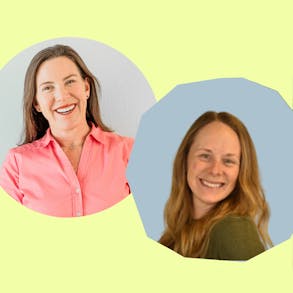
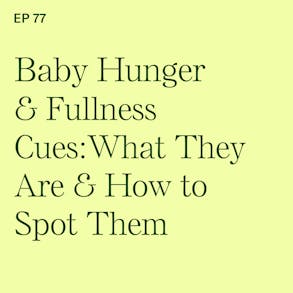
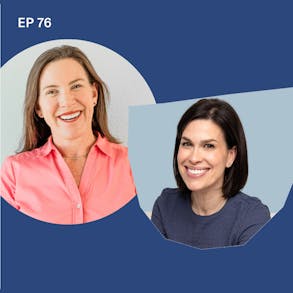
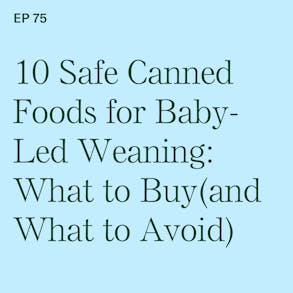

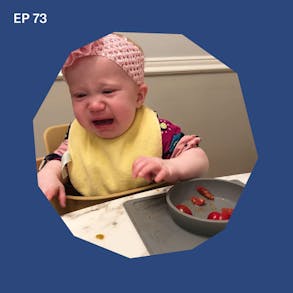
Katie Ferraro (1s):
I want to share a new podcast that I've been listening to called Meditation for Moms. So I am a self-proclaimed, high strung person. I know I'm a very fast talker. I have never been able to meditate on my own. So having a guide walk me through these Meditations and the fact that the Meditation for Moms show is geared towards the realities of being a mom has been so helpful. The Meditation for Moms podcasts is perfect if you're looking for Meditations for all of the seasons and circumstances and the peaks and the valleys of motherhood. The show's a little different because it's a podcast that's guided by a multitude of Moms, each of whom brings their own experience and their gifts to their Meditations. I know today I listened to a Reiki Meditation for Mothers episode, which is definitely outta the ordinary for me, but really helpful for calming before the workday started.
Katie Ferraro (49s):
You can check out all of the Meditation podcasts at https://womensmeditationnetwork.com and then select the Meditation for Moms or search Meditation for Moms wherever you get your podcasts at six months of age.
Ever Eden (1m 2s):
In addition to starting Solid Foods, your baby can also start to wear sunscreen. I recently interviewed Dr. Rebecca Hartman. She's a dermatologist and one of the Moms in medicine advisors to ever eat in. So Ever Eden is my favorite brand of non-toxic skincare for babies and kids. And so ever Eden has a line of mineral sunscreens that you can start using on your baby beginning at six months of age. And Dr. Hartman was teaching about the difference between chemical sunscreens and mineral sunscreens and the advantages of using mineral sunscreens on the more sensitive baby skin. So I used the Ever Eden's sheer botanical mineral sunscreen on my face every day. It's the only face sunscreen I found that has zinc, but it's still super light rubs in all the way, doesn't make you look like a ghost. and they have a kids' sunscreen line now too. You can get 15% off all of the Everdeen non-toxic skincare products with my affiliate discount code KATIE15. That code is KATIE15 at https://www.ever-eden.com/. And I hope you love their mineral sunscreens in your family as much as we do in ours.
Katie Ferraro (2m 1s):
And what I loved about analyzing the Sodium Limits for Babies Around, the World, is that nobody in any other country has their act together about quote unquote how much Sodium a baby can have. And so my rule of thumb that I've been sharing since 2016, which is we look for less than 100 milligrams of Sodium per serving in a food that you're about to feed your baby, is based on two assumptions. Number one, that those portion sizes that you see on the Nutrition Facts panel, the are reflective of adult portion sizes, right? Cuz there's no such things as baby portion sizes. And I know your baby's amazing, but they're not gonna eat a half a cup of kidney beans. And on top of that, we have to take into account the fact that the package and processed Foods, those are sometimes Foods. A lot of the Foods that we're making for our baby are wholesome, natural, intact Foods that contain no Sodium.
Katie Ferraro (2m 43s):
So on occasion, having a food that has less than a hundred milligrams of Sodium that came out of a package for me as far as I'm concerned as a dietitian and a mom, it's totally fine. Hey there, I'm Katie Ferraro, Registered dietitian, college nutrition professor and mom of seven specializing in baby-led weaning here on the Baby-led Weaning Made Easy podcast. I help you strip out all of the noise and nonsense about feeding, leaving you with the confidence and knowledge you need to give your baby a safe start to Solid Foods using Baby-led weaning. When you are at the grocery store and you are deciding and picking out which Foods you're going to offer to your baby, do you read food labels?
Katie Ferraro (3m 26s):
Like do you flip the package or the can or the product over and scan that Nutrition Facts panel looking for particular nutrients and If you do? Which nutrients are you looking at? Because there's a lot of information on the Nutrition Facts panel and you've probably realized that there's no such thing as an infant portion size that's listed. So how do you even interpret the information on the Nutrition Facts panel? In this episode, we're gonna do a high level Label Reading 101, what to look for in Foods that you offer your baby. So I'm a Registered dietitian, I'm also a college nutrition professor and I've taught college nutrition for 15 years at this point. And every introduction to nutrition science course that I teach, I do both graduate and undergraduate.
Katie Ferraro (4m 6s):
But at the undergraduate level, like the first nutrition class you're taking, in the intro week, we spend about three hours analyzing the nutrition facts panel and learning everything about what the FDA says about what has to be on the Label, what doesn't, how do you interpret it? The rounding rules. You know the rules for ingredient listing. Like if you're in the food space, then you totally understand the nutrition facts panel and then for the rest of the world, they don't use that information. Okay? We know from data that your typical American consumer does not utilize the information on the Nutrition Facts panel to make healthful food decisions, but there's like a lot of info in there except I know you don't have three hours to go through it.
Katie Ferraro (4m 46s):
So the impetus for this episode came from a message that I got from a mom named Savannah. So Savannah wrote to me and said, can you please break down the nutrition facts? You should teach about all of the nutrition facts labels on the Foods at the grocery store that Moms need to know? Cuz before I started baby-led weaning, this is Savannah talking. She said, I never even glanced at Nutrition Facts. Now I'm always looking, except I'm not a hundred percent confident on what I'm looking for. Some topics to cover in that episode. Bullet point, I love Savannah, she basically outlined the episode for me. What is fiber? What are saturated versus unsaturated fats? What things should I watch out for? What's good slash bad for Babies? How much Iron is good?
Katie Ferraro (5m 26s):
What are the brands required to report or not required to report? What does less than one gram mean? Do I ignore the percent dv that's a percent daily value info since I'm feeding a baby? I loved all of these questions and I was like, you know what? It is totally confusing. And yet at the end of the day, I mean I'm sure it would be great If you all like grew all your food from scratching your home gardens and never utilized any packaged Foods with nutrition facts panels on them. But in real life we go to the store and we buy ingredients and Foods that we work into age appropriate, developmentally appropriate ways that our Babies can safely feed themselves. And I get it, you don't have three hours to decipher how to learn about a nutrition facts panel. So I wanna boil it down to the three areas on the nutrition facts panel that I look when I'm deciding whether or not this is a food I'm going to feed to a baby.
Katie Ferraro (6m 13s):
Let's start with sugar. Okay? Sugar used to be super confusing. So prior to 2020 there was a line on the nutrition facts panel. It just said Sugars and it included both naturally occurring Sugars and Added Sugars. This was probably the most aggravating thing about Label rating as a dietitian because it was just a way for the manufacturers to hide behind, oh, this is our proprietary information. We don't wanna share our exact recipes, but consumers didn't get to know, Hey, how much of the sugar in that product is natural versus how much is added? And I'll give you a perfect example. Some of these yogurts that are marketed to kids. So just as some history in 2016, the nutrition facts panel in the US was updated to include grams of added sugar. And there were a couple of other changes that were made as well.
Katie Ferraro (6m 54s):
Like some of the formatting changed and the micronutrients that were mandated to be displayed changed. But as a Registered dietitian, especially when working in the infant feeding space, the thing I was most excited about and continue to be most excited about is that finally manufacturers had to divulge the number of grams of added sugar. So that inclusion of Added Sugars that was intended to help consumers make more informed choices about the Foods that they eat, and then raise awareness about the amount of added sugar that processed Foods have and really try to curb that. So even though the proposals started in 2016, the updated nutrition facts panel became mandatory for most food manufacturers in January of 2020. So in the pre 2020 era like If, you had a yogurt for example, that's marketed to kids and it would say X number of grams of sugar.
Katie Ferraro (7m 38s):
Okay? You would've to be a dietitian to know that one cup slash eight ounces of yogurt has 12 grams of carbohydrate that come from lactose, which is a naturally occurring milk sugar. So if a product said it had 32 grams of sugar in the eight ounce container, I would do the mental math in my head, okay, 32 grams of sugar minus the fact that I know 12 of those grams are naturally occurring in one cup of yogurt. So there's 20 grams of added sugar and 20 grams of added sugar divided by four grams of sugar per teaspoon means there's five teaspoons of sugar in this yogurt product that that manufacturer says is for my kids. And here's the deal, we don't want kids to have any added sugar and for Babies we keep it to zero grams of added sugar.
Katie Ferraro (8m 20s):
So the American Academy of Pediatrics recommends zero grams of added sugar for children zero to two. So this is a super easy place for you to start If. you turn a package over and it says anything except zero grams of added sugar, then don't offer it to your baby. Okay? Because we want our Babies to be getting nutrition and learning how to eat Foods that have naturally occurring nutrients in them and naturally occurring sugar is fine. Okay? Right? The carbohydrate that you find in some dairy Foods with cheese through the processing, the carb has been removed. That's why like you know, people on low carb diets eat cheese, okay? But other dairy products like milk and yogurt products, they have naturally occurring carbohydrate that comes from the natural milk sugar lactose If. you look at starchy Foods or whole grains, like all the 20 different starchy Foods on our 100 FIRST FOODS list, they're great sources of carbohydrate for Babies.
Katie Ferraro (9m 5s):
Most of them are whole grain, okay? These are quote unquote Sugars, okay? This is what your body, this is what the baby's body converts to sugar and uses it as Fuel to help that growing body continue to grow and thrive. But it's not Added Sugars. So the Added Sugars are what we wanna stay away from. And thankfully because of the updated nutrition facts panel, we can now skip right to the grams of added sugar line and we're looking for zero grams If, you are confused about Added Sugars or you wanna learn more. In episode 3 0 9, I did a whole deep dive on Added Sugars and which ones to avoid for baby led weaning. But the answer is really all of them. But we talk a little bit about the nuances and the differences between it. We're looking for zero grams of added sugar cuz your baby needs naturally occurring sources of sugar and not Added Sugars.
Katie Ferraro (9m 45s):
Hey, we're gonna take a quick break, but I'll be right back.
Katie Ferraro (10m 40s):
The second area where I go to look on the nutrition fax panel is to the Sodium line. So Sodium is a mineral, it's important, right? We don't say oh zero milligrams of Sodium because like Sodium is an electrolyte and it's responsible for lots of important things and nerve transmission in your body, like ah, making your heartbeat. So we don't go to zero, okay? But there's no hard and fast rules about quote unquote how much Sodium a baby can happen. And we've explored this a lot on the podcast. One of my favorite episodes, Lauren on my team, makes fun of me cuz she says, you always say that. That's like the most downloaded episode. But I'm gonna tell you, this one was not very well received by the community and yet it was still one of my favorite episodes. Episode 2 53, our intern at the time, and I did a deep dive on Sodium Limits for Babies Around the World.
Katie Ferraro (11m 23s):
Usually when we do Sodium stuff it like the downloads go crazy, this one did not, I don't know If, you guys don't care about other countries, but I loved the fact that nobody else has their act together around the world with deciding how many milligrams of Sodium a day a baby should have. And it's hard because Sodium is an essential nutrient, right? Like you do need to get some of it from the Foods that you eat and drink and If, you look, breast milk has Sodium. Or when you move your baby to cow's milk, for example, sometimes parents are surprised to say, gosh, one cup of cow's milk has 120 milligrams of Sodium. Like where is it all coming from? Well, you know, a lot of Foods, there's naturally occurring sources of Sodium. And we talk about that especially on this podcast in the context of like shellfish and fish, which are two separate Allergenic food categories. They're naturally high mineral Foods, meaning that they're going to contain higher levels of certain minerals, including Sodium.
Katie Ferraro (12m 8s):
It's not added Sodium. So the language that I use is that we want to avoid excessive Sodium, right? Cuz you don't want to train your baby's taste buds to expect the salt and not learn how to taste the flavors of the food So. in episode 33, we did another kind of deep dive on salt and I shared three Easy, Ways, To, Minimize, Sodium, For, Your Baby like If. You've never paid attention to salt and Foods. When you go to start Solid Foods with your baby, take a scan at the Sodium levels. Now people are like, okay, well what are you looking for? My rule of thumb, and again this is not a published guideline with regards to Sodium for Babies, but I am comfortable with, if a product says it has less than 100 milligrams of Sodium per serving, I'm comfortable offering that to my baby.
Katie Ferraro (12m 49s):
And that's a good benchmark I think for most parents to start at. Cuz like If, you go for example in the canned food aisle, you can find a can of kidney beans. Let's say we make this tomato kidney bean pie for baby-led weaning in our program and we show parents how to make it, it's quite easy and it relies on a can of kidney beans. And you can buy three different types of kidney beans at my typical grocery store down the street. Regular kidney beans which have 360 milligrams of salt per half cup serving. You can buy reduced Sodium ones that have somewhere in the like one 50 to 200 range. Or you can buy no added salt, which have 15 milligrams of Sodium per serving. Okay? We're talking about 15 to like the mid three 50 s. You wanna choose the one that has less than a hundred milligrams of Sodium. So we're looking for no added salt and no salt options.
Katie Ferraro (13m 32s):
And I hear silly things and see it on social media. Oh, Babies can't have canned Foods. Some canned Foods are very high in salt. Salt is very cheap preservative, it's the cheapest, right? But also there's many, many brands and varieties and even within the brand they have a line that's no added salt. So just rate your labels and look for if it's less than a hundred milligrams of Sodium. And the reason why I created that guideline, and I've been recommending products with 100 milligrams of Sodium or less, four Babies, four baby led weaning since 2016. I was like, well, well why? How did you come up with that? Well, two things come to mind. Take into account that the portion size that's listed on the package is not representative of what your baby's actually going to eat. Like a portion size of kidney beans is a half a cup. I know your baby's awesome, but they're not gonna eat a half a cup of kidney beans.
Katie Ferraro (14m 14s):
And on top of that, I also take into consideration that most of the Foods that I'm offering my baby when possible are wholesome full intact ingredient Foods that are not packaged for processed Foods. But sometimes we rely on canned or frozen or processed slash packaged Foods to offer or to help our baby learn how to eat new Foods. And that's totally fine, just keep an eye on the Sodium and try to keep it to less than a hundred milligrams preserving If you can. So there's sugar at zero grams of Added Sugars preserving for Babies Sodium. A good rule of thumb is less than a hundred milligrams of Sodium per serving. And then Iron is the third area where I'm always looking at on the nutrition facts panel. Now keeping in mind that there are categories of Foods such as fruits and vegetables where those Foods contain almost no Iron.
Katie Ferraro (14m 56s):
so you can't go out and find a high Iron fruit, a high Iron vegetable. Those aren't the food categories. Where we want our Babies getting Iron from Iron comes from protein Foods, both animal and plant Foods as well as some of the starchy Foods, especially if we're prioritizing the whole grain. And then on our Allergenic Foods list, many of those Foods because they are protein Foods cuz that's the potentially Allergenic part of the food, they would also have Iron in them. So part of kinda the beauty of my five-step feeding framework where we introduce five new Foods to your baby per week is that we're pulling from each of the categories, right? On Monday we do a new fruit. On Tuesday we do a new vegetable. On Wednesday we do a new starchy food. On Thursday we do a new protein food. On Friday we do a new Allergenic food. As you sequence through that every week introducing your baby to five new Foods, one from each of the different five food groups, you're naturally pulling Foods with different textures, with different flavor profiles and with different nutrient composition.
Katie Ferraro (15m 47s):
Meaning that some of those Foods will have Iron and some of the other Foods like the fruits and the vegetables, they don't have Iron, but guess what? They have vitamin C And vitamin C helps your baby's body absorb Iron from the other Iron containing Foods that they're learning how to eat. So it's all kind of working in unison there. So we don't overp prioritize or pay homage to one nutrient, like protein is the best thing ever. No it's not. your baby needs small amounts of all of the different macronutrients, which are proteins, fats, and carbs, and the micronutrients which include the vitamins and the minerals. And having a variety of Foods and helping your baby achieve diet diversity will ensure that they're getting all of that nutrition. So I know that Iron makes you guys freak out and they know that because when we do Iron episodes, much like Sodium, for the most part, people are like, oh my gosh, that's exactly what I was asking.
Katie Ferraro (16m 33s):
I was wondering. And one of my favorite episodes about Iron that we did was episode 169. It's called Iron Does My Baby Really Need to Eat, 11 milligrams of Iron per day. And I loved that episode cause we really examined how scientists and nutrition researchers arrive at the 11 milligram dietary reference intake for baby seven to 12 months of age. And it's based on some pretty wild assumptions like that. Babies don't eat meat and we know that If, you family eats animal Foods. Babies can learn how to eat meat. So I don't want you to be stressing about how many milligrams of Iron your baby is eating because your baby can get enough Iron from the Foods that they're learning how to eat. And you've got this huge insurance policy called Infant milk.
Katie Ferraro (17m 14s):
So breast milk or formula is still continuing to provide nutrition, mainly Iron as well as other things, even While, you're starting Solid Foods. So we introduce Iron containing Foods as part of the Weaning diet. But I don't want you to stress out like, oh my gosh, at six months of age my baby needs to be getting a hundred percent of their Iron from food. Cuz that's just not true. And If, you are stressed about Iron. Go listen to episode 137. That one was called Iron Can My Baby Get Enough Iron from Baby, Led Weaning Foods. They talk about how yes, they most certainly can, it doesn't happen overnight, but that's okay cuz it doesn't have to. Hey, we're gonna take a quick break, but I'll be right back.
Katie Ferraro (18m 60s):
So what do I look for on the nutrition facts panel when it comes to Iron? Well, if a food contains one milligram of Iron, I consider that an Iron food. We don't say it's high Iron or high in Iron or a good source of Iron because there's actually different labeling requirements and rules as far as how the number of milligrams of a micronutrient stack up against the daily value to whether or not you can say it's good high in low in et cetera. So I just call it an Iron food also because the nutrition fax information and the percent daily value information on that nutrition fax panel that's reflective of adult needs. So we don't, you don't see them posted in the regular Foods that you're buying at the grocery store for your baby. If you're buying special processed baby Foods for your baby, then sometimes they will have a baby column.
Katie Ferraro (19m 42s):
But if not necessary, you can pretty much just ignore the percent daily value and know like, hey, I gotta find some one milligram Iron Foods that my baby can eat. And a lot of the Foods in the starchy Foods category of our 100 FIRST FOODS list, and most of the ones in the protein category have one milligram of Iron or more. Okay? Now your baby's not gonna eat that whole portion size, that's understandable. But you the parent are getting in the habit of learning which Foods contain Iron, and then teaching your baby how to safely eat those Foods so that as they wean off of infant milk, that insurance policy kind of starts to go away. Especially as we get close to the one year mark when most of baby's nutrition can be coming from food and just a small amount comes from infant milk At that point, great, cuz your baby already knows how to eat all of these different protein Foods and starchy Foods that do contain Iron.
Katie Ferraro (20m 27s):
So keep your eyes peeled for one milligram of Iron or more. That's a good Iron food. But no, it's not gonna happen in every food cuz food categories like fruits and vegetables, those are low Iron Foods, and that's okay. Not all Foods have to contain Iron, but you do have to include Iron, contain Foods in your baby's Weaning diet. So to summarize, the three places where my eyeballs are gonna go, if I've got a split second in the grocery store to analyze whether or not I'm feeding this food to the baby Added Sugars, I wanna see zero grams Sodium. I'm looking for less than a hundred milligrams per serving. An Iron a love me, a one milligram of Iron food on occasion, knowing that not all Foods can have that much Iron and that's okay, and some have a lot more If. you wanna grab a copy of that a 100 FIRST FOODS list so you can pick out the high Iron protein and starchy and Allergenic Foods that your baby can learn how to eat.
Katie Ferraro (21m 9s):
Also, that happen to be low in Sodium with no added sugar. You can grab a copy of my 100 FIRST FOODS list. It's free to everybody who takes my free online video workshop called Baby Led Weaning For Beginners. I just rerecorded the whole thing. I love this workshop. It's about 75 minutes long at this point. Now, we just added in a lot of videos to kind of give you the visual of what the safe food preparation methods are so that you can be making these nutritionally appropriate Foods in a safe manner. Cause it doesn't matter like how quote unquote perfect the nutrition is. If you're not preparing the food safely, then your baby can't eat it. We talked about kidney beans In, this episode. we don't offer intact kidney beans to early eaters in phase one of baby-led weaning. They don't have their pin or grasp, they can't pick them up, but I can show you how to work them into the tornado tomato, kidney bean pie recipe, which you can cut into strips about the size of your adult pinky finger.
Katie Ferraro (21m 54s):
Your baby can pick it up and feed it to themselves. If. you wanna learn more all about this stuff and get the 100 FIRST FOODS list. Sign up for that workshop. It's at https://babyledweaning.co or you can click the link. That's where you're listening to this podcast episode. It's in the description. It'll also be on the Shownotes along with some of those other episodes that I mentioned, If you wanna go back and review more about Added Sugars, about Sodium and about Iron. Those Shownotes will be linked up for you at https://BLWpodcast.com/351. Thank you so much to our partners at AirWave Media. If, you guys like podcasts that feature food and science and using your brain. Check out some of the podcasts from AirWave Media. We're online at BLW podcast.com. Thanks so much for listening, and thank you to Savannah P.
Katie Ferraro (22m 35s):
Thanks Savannah for sending me all the ideas for this episode. See you guys next time in.
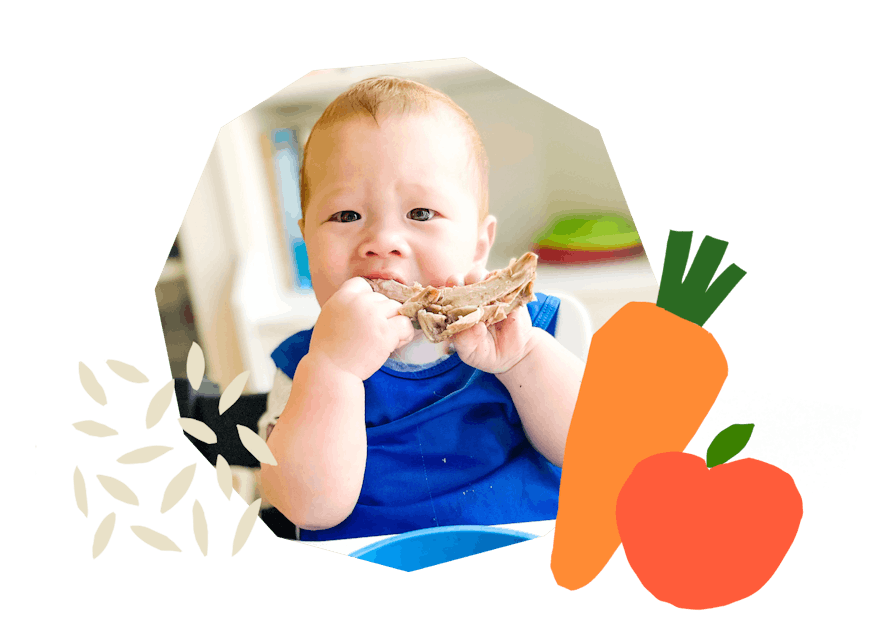
The Program Baby-Led Weaning with Katie Ferraro
A step-by-step digital program for starting solid foods safely and navigating the original 100 FIRST FOODS™ meal plan with baby-led weaning.
 EXPERT-LED, PROVEN APPROACH TO EATING REAL FOOD
EXPERT-LED, PROVEN APPROACH TO EATING REAL FOOD CONCISE VIDEO TRAININGS TO MASTER BABY-LED WEANING
CONCISE VIDEO TRAININGS TO MASTER BABY-LED WEANING 100 FIRST FOODS DAILY MEAL PLAN WITH FOOD PREP VIDEOS
100 FIRST FOODS DAILY MEAL PLAN WITH FOOD PREP VIDEOS
Baby-Led Weaning for Beginners Free Workshop
Is your baby ready to start solid foods, but you’re not sure where to start? Get ready to give your baby a solid foundation to a lifetime of loving real food…even if you’re feeling overwhelmed or confused about this next stage of infant feeding.
Get baby-led weaning recipes and tips delivered to your email inbox.

